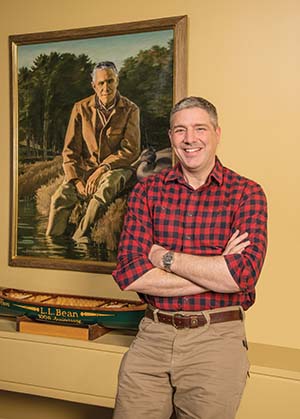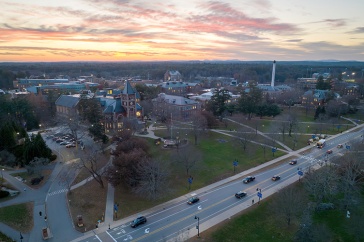
Shawn Gorman ’89 is just the third chairman in the 103-year history of L.L. Bean, legendary retailer of everything from fly-fishing rods to flannel pajamas—and those boots.
What is it about the boots, exactly?
That’s the question in front of Shawn Gorman ’89 at the L.L. Bean corporate headquarters in Freeport, Maine, on a late fall afternoon. Gorman is uniquely qualified to explain how L.L.Bean Boots—heavy rubber and leather boots also known as the Maine Hunting Shoe—have transcended their utilitarian roots to become a winter-fashion staple, right up there with a classic pea coat or a Burberry scarf.
He's the chairman of the board for the 103-year-old Maine company, which sells everything from sweaters and jeans to camping, hunting and other outdoor gear. He’s also the father of three high schoolers—two girls and a boy—and is therefore tuned into what the latest thing is when it comes to fashion trends.
And when it comes to footwear, Bean Boots are about as hot as it gets this winter, although the product (the company’s original) dates back to 1912. In fact, there’s been a bit of a shortage of the boots for the past several months. Long-loved by outdoorsmen for their all-weather durability, Bean Boots have spiked in popularity among the teens-and-20s sets, with students from Caribou to California clamoring for the must-have campus wear and creating a backorder of some 75,000 pairs that is expected to last well into spring.
But how exactly did the born-out-of-function-not-fashion boots become a must-have for a whole new generation? Gorman attributes the boots’ popularity to a reissue in 2012 that coincided with L.L.Bean’s 100th anniversary.
“I think it brought some attention and focus back to this really functional product that actually also has some good style to it,” he says.
The Bean Boot’s resurgence is also the result of a key merchandising strategy: taking heritage products and tweaking them a bit for contemporary consumers. As part of the reissue, Bean introduced a waxed canvas Bean Boot, offered the boot in a variety of colors beyond the classic brown-and-tan and served up several insulated options, lined with Gore-Tex, Thinsulate and/or shearling.
National media outlets like ABC News and NPR have picked up the story of the Bean Boot backlog, but Gorman’s work— and indeed the legend that is L.L.Bean—is about much more than the latest fashion trend. Since taking over as chairman of the board in 2013, Gorman has overseen the expansion of Bean’s brand, including the opening of four new retail stores, and continued the push to get Bean products into new customers’ homes—all while maintaining the company’s commitment to its existing customer base.
Great-grandson of company founder Leon Leonwood Bean, Gorman never thought he’d end up working in the family business—he envisioned a professional life writing copy or working in some other similar creative position in an advertising agency. He spent a few years working in sales—interesting, he says, but not challenging—and then in 1992, he came home to Bean. It was a job in advertising, but not on the creative side, working as an analyst.
Gorman’s role gave him a 360-view of the company’s advertising, measuring the effectiveness of Bean’s direct marketing and advertising campaigns. It was direct marketing 101, he says, and he loved everything about it. For the next two decades, he worked in various positions within the company—as manager of international marketing operations, director of advertising and partnership marketing, vice president of card services and direct-to-business, and finally senior vice president of brand communications. Then in 2011, the family began discussing a succession plan for his uncle, Leon Gorman, who had served as president and CEO and then chairman for nearly 40 years, taking the business from $5 million to more than $1 billion plus in annual sales.
The plan for the privately held company was simple: Leon would stay on as chairman for an additional two or three years, at which time Shawn— then comfortable in his role as senior vice president of brand communications—would step into the chairman’s position. But Leon delivered a surprise: he wanted to make the transition happen in six months. Suddenly, the weight of the company’s history, as well as the fate of the 5,000 year-round employees who work there, rested squarely on Gorman. He would be at the helm of a $1.6 billion family business. He would be just the third chairman in the company’s century-plus history. Was he ready?
“While the transition plan had been in the works, you don’t realize the responsibility until it actually happens,” Gorman says. “It definitely put some weight on my shoulders, but then I realized this is much more than one person, it’s the 5,000 people who are dedicated to the success of this company. Fairly quickly you realize we have an excellent CEO and outstanding talent in our management — both at the executive level and the middle-management level. So my anxiety quickly transitioned to a sense of comfort.”
To be sure, running a family business brings a unique set of challenges. Most family businesses, Gorman points out, don’t make it to a third generation; Bean is in its fourth generation of family ownership. But what if a family member who works at Bean isn’t pulling his or her weight? Or, what if the opposite is true: what if a young family member is really doing well, and you want to promote him or her? Will that seem like family favoritism in a company where the vast majority of employees do not carry the Bean or Gorman name?
Every situation is different, Gorman says diplomatically, and while there haven’t been any fights around the family Thanksgiving table, difficult conversations do come up around the corporate headquarters’ conference table at times. And deciding who among the family weighs in on certain business decisions can be tricky sometimes, as well.
In those moments, Gorman thinks of the company like an airplane. “As the owners of an airplane, you can decide to paint the plane whatever color you want, determine the clientele, determine where you want to fly,” he explains. “But you hire people with expertise to fly the airplane. The owners stay out of the cockpit.”
CATCHING NEW CUSTOMERS' EYES
“We don’t answer to Wall Street, we answer to Casco Street.” It’s a phrase Gorman has used in media interviews before, referring to the company’s headquarters, but it’s much more than a catchy slogan. In a company whose senior managers don’t need to lie awake at night worrying about things like stock price and shareholder satisfaction, it’s an articulation of Bean’s outlook on its standing and priorities. “We’re looking out over five to 10 years to make sure we remain viable for the long-term,” Gorman says.
Today, Bean is at a critical juncture in its long history. The company has fierce brand loyalty, with shoppers returning for its quality products year after year through catalog and web orders or by visiting one of 26 L.L.Bean stores across the country. The Bean target customer is anyone who shares a love of the outdoors, Gorman says, whether he or she is climbing Everest or day-hiking in the Presidentials. But at the same time, Bean has to stay nimble and win new customers. And yes, that means seeking a younger audience.
Under Gorman’s leadership, Bean has opened new retail spaces—in Denver, at Minnesota’s Mall of America and in Burlington, Vt. “Retail provides us the opportunity to expand our reach to new customers in new markets. We see our stores as an extension of the brand and brings our catalog to life,” he explains.
The retail stores aim to catch the eye of young shoppers, a demographic that doesn’t shop from catalogs, and Gorman has a vision of what it can look like when a non-customer first discovers the Bean brand. “If they think they know L.L.Bean and that it’s not for them, they won’t be picking up a catalog,” he says. “But as that same person is walking through an outdoor mall, and he or she sees a beautiful storefront presentation with kayaks and bikes and active apparel… they’ll be drawn to it.”
Indeed, at the Mall of America opening, L.L.Bean’s vice president of retail Greg Elder told the large crowd that Bean sees Minnesota and Maine “as something like long-lost brothers,” because of both states’ outdoorsy nature. And a local newspaper writer penned a column reflecting on the opening as a sentimental experience:
“It was the tote bags that got me. Right there at the entrance to the new L.L.Bean store at, of all places for an outdoors writer on assignment, the Mall of America. There they were, hanging on hooks, like my mom’s ever-present Bean tote hanging on a wooden peg in our kitchen where I grew up. My mom’s Bean bags —or so we called them—held any assortment of things totes carry: a mother’s pursely goods, a Thermos of hot chocolate and extra mittens for a day skiing, several balls of yarn from a half-finished sweater. . .
“Wow. An emotional reaction at a store in the Mall of America,” wrote Dave Orrick of The Pioneer Press.
THE UNH EXPERIENCE
Last fall, Gorman and his wife, Cari, took part in a regular parental rite of passage: touring colleges with their son, a high school junior. The experience took the 48-year-old back to the time when he was thinking about colleges. An Exeter, N.H., native, Gorman spent his high school years as a boarding student at Brooks School in North Andover, Mass., and the university just up the road from home was at the top of his list for a few different reasons. A close friend from Brooks had gone on to UNH and kept in touch, sharing how much he was enjoying his freshman year. And Gorman found Durham’s proximity to Portsmouth and Boston, combined with the campus’ rural setting and beauty, appealing.
“When you picture in your head what an idyllic college campus would look like, UNH meets that criteria, with T-Hall lawn, the walkways, the library … it worked well for me,” he says. “Looking at colleges with my son now, he has the same kind of view I had, which is interesting.”
Gorman studied business for his first two years, but “probably didn’t give business school much of a chance.” He spent his sophomore spring interning at a resort hotel, thinking perhaps a hospitality career was in his future.
“It was a valuable experience — it made me decide I didn’t want to go into hospitality,” Gorman laughs. He came back his junior year and made the decision to transfer into the College of Liberal Arts, graduating a year later with a degree in English.
These days, with a shifting economy and the job market more in flux than ever, Gorman’s advice to current UNH students is to keep their options open. Jobs that exist now didn’t exist 25 years ago, he says, so it’s important to stay flexible.
“For myself, I didn’t pinpoint any one career path; I would tell students to be open to new opportunities,” he says. “And I know it might sound cliché but I would also advise them to love what they do. Pursue what they are passionate about. Obviously sometimes you just need to get a job, but when you can find a job you love, if you can see the rewards for hard work and you feel like you’re contributing something, it makes working harder that much more fun.”
That’s just what Gorman has found in his family’s business. While the day-today work features a lot of meetings, it’s also about maintaining high standards for everything from kayaks to maple syrup, and making sure the customer is happy with his or her purchase. That’s why, while it might not have been love at first sight with his family’s legacy, it’s certainly a strong relationship now.
“I love this company. I’m not sure I did when I was younger, when I didn’t know as much about it. But as I’ve come to work here and grow here and lead here, I’ve come to see what this company means to the community and to Maine itself.”
Our interview with Shawn Gorman '89 included a few random questions about L.L. Bean and also about Gorman's time in Durham. Read more in Of Boots and Business.
Can't get enough L.L. Bean background? Read more about their famous return policy and L.L. Bean in popular culture in More Bean's Background.
Originally published in UNH Magazine—Winter 2015 Issue
-
Written By:
Michelle Morrissey ’97 | UNH Magazine | michelle.morrissey@unh.edu

















































